Timeline Header
-
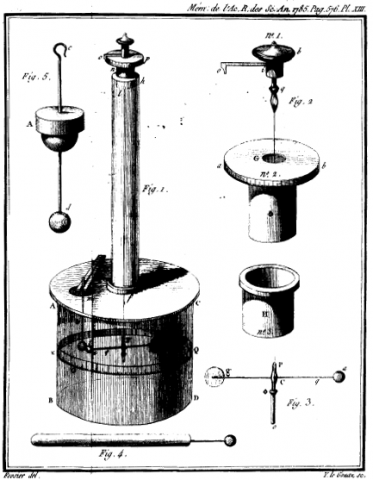
First observations of the spontaneous discharge of an electrometer
The torsion balance electrometer Coulomb used to make his observations (Image: Wikimedia commons) In 1785, the French physicist Charles Augustin de
Know more28/06/1785 -
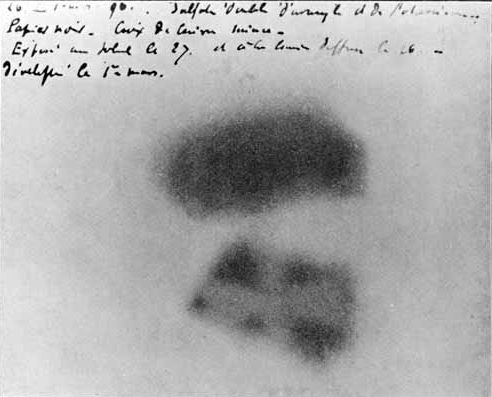
Becquerel discovers radioactivity
The first evidence for radioactivity – images formed by Becquerel’s uranium salts (Image: Wikimedia Commons) French physicist Henri Becquerel
Know more26/02/1896 The source: Earth, atmosphere or outer space?
In studying electrical conduction through air in 1899, Julius Elster and Hans Geitel designed a key experiment where they found that surrounding a
Know more05/05/1899-
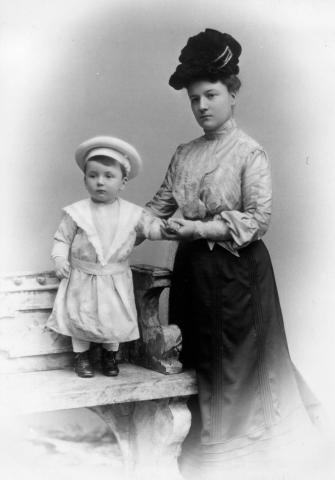
Bertha Pauli’s son Wolfgang is born
Bertha Camilla Schütz (known as Maria) was born in Vienna in 1878. A writer and journalist, she followed in her father’s footsteps as collaborator on
Know more25/04/1900 Albert Einstein publishes his theory of Special Relativity
On 30 June 1905 the German physics journal Annalen der Physik published a paper by a young patent clerk called Albert Einstein. The paper, Zur
Know more30/06/1905-
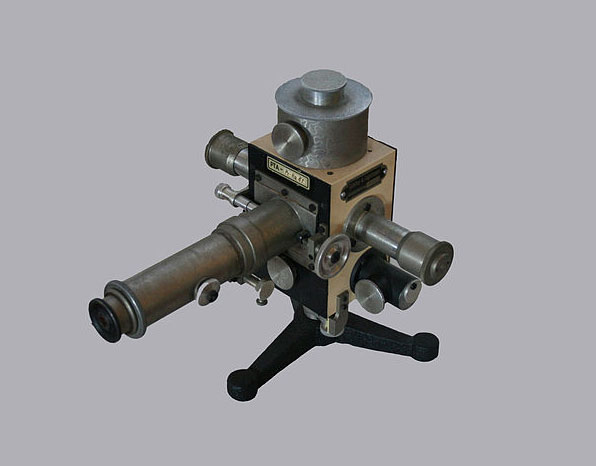
Theodor Wulf, a new electrometer, and the Eiffel tower
The original Wulf electroscope (Image: Wikimedia Commons) In 1909 Theodor Wulf, a Jesuit priest, designed and built a more sensitive and more
Know more01/03/1909 Albert Gockel’s flights
To measure ionizing radiation away from the earth’s surface, several researchers took to the air in balloon flights in the first decade of the 20th
Know more15/10/1910-
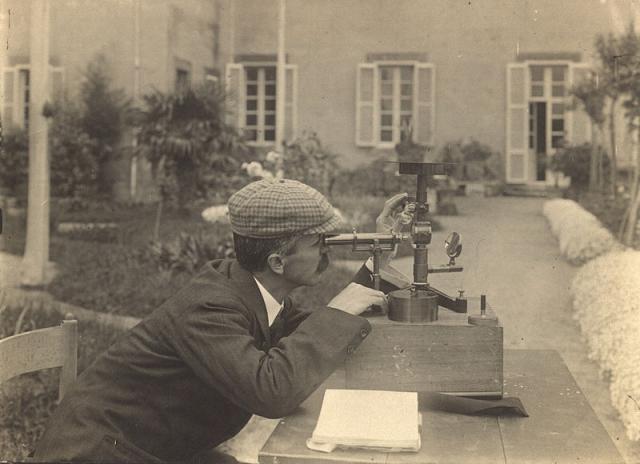
Pacini and underwater measurements
Domenico Pacini making a measurement on 20 October 1910 (Image: Wikimedia Commons) In 1911, Italian physicist Domenico Pacini took readings on a
Know more02/04/1911 -

Charles Thomson Rees Wilson sees particle tracks
Cloud formed on ions due to α-Rays (Image: CTR Wilson Roy, Proceedings of the Royal Society A, Volume 85, Plate 9) The cloud chamber was fundamental
Know more09/06/1911 -
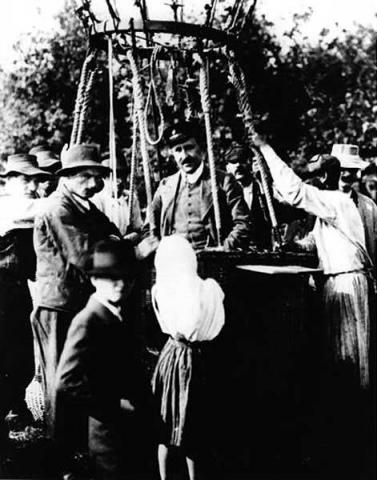
Victor Hess discovers cosmic rays
In 1911 and 1912 Austrian physicist Victor Hess made a series of ascents in a balloon to take measurements of radiation in the atmosphere. He was
Know more17/04/1912
First observations of the spontaneous discharge of an electrometer
 The torsion balance electrometer Coulomb used to make his observations (Image: Wikimedia commons)
In 1785, the French physicist Charles Augustin de Coulomb made three reports on electricity and magnetism to France’s Royal Academy of Sciences. His third paper described an experiment with a torsion balance, which showed that the device would spontaneously discharge due to the action of the air rather than defective insulation.
In 1850, Italian physicist Cano Matteucci and later British physicist William Crookes in 1879 showed that the rate of spontaneous discharge decreased at lower atmospheric pressures. The search for an explanation for the nature of this spontaneous discharge paved the way for the discovery of cosmic rays – high-energy particles from outer space.
Read more: Extract from Mémoires sur l'électricité et le magnétisme (1785-89) by Charles Augustin de Coulomb.
The torsion balance electrometer Coulomb used to make his observations (Image: Wikimedia commons)
In 1785, the French physicist Charles Augustin de Coulomb made three reports on electricity and magnetism to France’s Royal Academy of Sciences. His third paper described an experiment with a torsion balance, which showed that the device would spontaneously discharge due to the action of the air rather than defective insulation.
In 1850, Italian physicist Cano Matteucci and later British physicist William Crookes in 1879 showed that the rate of spontaneous discharge decreased at lower atmospheric pressures. The search for an explanation for the nature of this spontaneous discharge paved the way for the discovery of cosmic rays – high-energy particles from outer space.
Read more: Extract from Mémoires sur l'électricité et le magnétisme (1785-89) by Charles Augustin de Coulomb.
Becquerel discovers radioactivity
 The first evidence for radioactivity – images formed by Becquerel’s uranium salts (Image: Wikimedia Commons)
French physicist Henri Becquerel discovered radioactivity while working on a series of experiments on phosphorescent materials. On 26 February 1896, he placed uranium salts on top of a photographic plate wrapped in black paper. The salts caused a blackening of the plate despite the paper in between. Becquerel concluded that invisible radiation that could pass through paper was causing the plate to react as if exposed to light.
Marie Curie decided to study the new radiation using the sensitive electrometer invented by her husband, Pierre, to measure the conductivity of air that the radiation induced.
The discovery of radioactivity cultivated great research interest in Germany and the UK about the origin of the spontaneous electrical discharge observed earlier in the air. The simplest hypothesis was that the discharge was caused by the radioactive materials on Earth, though this was difficult to prove.
Researching natural radioactivity eventually lead to the discovery of cosmic rays.
The first evidence for radioactivity – images formed by Becquerel’s uranium salts (Image: Wikimedia Commons)
French physicist Henri Becquerel discovered radioactivity while working on a series of experiments on phosphorescent materials. On 26 February 1896, he placed uranium salts on top of a photographic plate wrapped in black paper. The salts caused a blackening of the plate despite the paper in between. Becquerel concluded that invisible radiation that could pass through paper was causing the plate to react as if exposed to light.
Marie Curie decided to study the new radiation using the sensitive electrometer invented by her husband, Pierre, to measure the conductivity of air that the radiation induced.
The discovery of radioactivity cultivated great research interest in Germany and the UK about the origin of the spontaneous electrical discharge observed earlier in the air. The simplest hypothesis was that the discharge was caused by the radioactive materials on Earth, though this was difficult to prove.
Researching natural radioactivity eventually lead to the discovery of cosmic rays.
The source: Earth, atmosphere or outer space?
In studying electrical conduction through air in 1899, Julius Elster and Hans Geitel designed a key experiment where they found that surrounding a gold leaf electroscope with a thick metal box would decrease its spontaneous discharge. From this observation, they concluded that the discharge was due to highly penetrating ionizing agents outside of the container. In a similar experiment at about the same time, Charles Thomson Rees Wilson in Cambridge came to the same conclusion. To test whether the ionizing radiation originated beyond the atmosphere, in 1901 Charles Thomson Rees Wilson took measurements of natural radioactivity using an electroscope inside an old railway tunnel in Scotland. If the radiation were coming from outer space, Wilson could have expected to measure a signification reduction in the tunnel compared to outside on the surface. But he saw no such reduction. Following Wilson’s observations, the scientific community largely dismissed the extra-terrestrial theory. Since some of the radiation was found to be too penetrating and perhaps too abundant to originate from known sources, altitude-dependent studies were carried out to test the idea of an extraterrestrial source – although at first the results were contradictory.Bertha Pauli’s son Wolfgang is born
 Bertha Camilla Schütz (known as Maria) was born in Vienna in 1878. A writer and journalist, she followed in her father’s footsteps as collaborator on the Neue Freie Presse, writing theatre reviews and historical essays. In 1899 she married Wolf Pauli and their first child was born on 25 April 1900. Wolfgang junior, seen here at the age of 20 months, grew up to be a Nobel prizewinning physicist, and his sister Hertha (1906-1973) became an actress and writer. Their mother was a pacifist, a socialist and a feminist, participating in the electoral campaign of 1919 to urge women to cast their newly won vote for the Social Democratic Party. She died (suicide) on 15 November 1927.
Bertha Camilla Schütz (known as Maria) was born in Vienna in 1878. A writer and journalist, she followed in her father’s footsteps as collaborator on the Neue Freie Presse, writing theatre reviews and historical essays. In 1899 she married Wolf Pauli and their first child was born on 25 April 1900. Wolfgang junior, seen here at the age of 20 months, grew up to be a Nobel prizewinning physicist, and his sister Hertha (1906-1973) became an actress and writer. Their mother was a pacifist, a socialist and a feminist, participating in the electoral campaign of 1919 to urge women to cast their newly won vote for the Social Democratic Party. She died (suicide) on 15 November 1927.
Albert Einstein publishes his theory of Special Relativity
On 30 June 1905 the German physics journal Annalen der Physik published a paper by a young patent clerk called Albert Einstein. The paper, Zur Elektrodynamik bewegter Körper, (On the Electrodynamics of Moving Bodies) set out Einstein's theory of Special Relativity, which explains the relationship between space and time – and between energy and mass – in the famous equation E=mc2. The paper used Planck's concept of energy quanta to describe how light travels through space.Theodor Wulf, a new electrometer, and the Eiffel tower
 The original Wulf electroscope (Image: Wikimedia Commons)
In 1909 Theodor Wulf, a Jesuit priest, designed and built a more sensitive and more transportable electrometer than the gold leaf electroscopes. He measured the ionization of the air in various locations in Germany, Holland and Belgium, concluding that his results were consistent with the hypothesis that the penetrating radiation was caused by radioactive substances in the upper layers of the Earth’s crust.
Wulf then started measuring changes in radioactivity with height to understand the origin of the radiation. The hypothesis was simple: if the radioactivity was coming from the Earth, it should decrease with height.
Wulf took his electroscope to the top of the Eiffel tower in 1909 and found that the intensity of radiation “decreases at nearly 300 m [altitude to] not even to half of its ground value”. This was too small a decrease to confirm his hypothesis.
However, unknown to Wulf, his results were due to the radioactive metal of the Eiffel tower. The search for the source of the mysterious ionizing radiation would continue.
The original Wulf electroscope (Image: Wikimedia Commons)
In 1909 Theodor Wulf, a Jesuit priest, designed and built a more sensitive and more transportable electrometer than the gold leaf electroscopes. He measured the ionization of the air in various locations in Germany, Holland and Belgium, concluding that his results were consistent with the hypothesis that the penetrating radiation was caused by radioactive substances in the upper layers of the Earth’s crust.
Wulf then started measuring changes in radioactivity with height to understand the origin of the radiation. The hypothesis was simple: if the radioactivity was coming from the Earth, it should decrease with height.
Wulf took his electroscope to the top of the Eiffel tower in 1909 and found that the intensity of radiation “decreases at nearly 300 m [altitude to] not even to half of its ground value”. This was too small a decrease to confirm his hypothesis.
However, unknown to Wulf, his results were due to the radioactive metal of the Eiffel tower. The search for the source of the mysterious ionizing radiation would continue.
Albert Gockel’s flights
To measure ionizing radiation away from the earth’s surface, several researchers took to the air in balloon flights in the first decade of the 20th century. One of these pioneers, Albert Gockel, measured the levels of ionizing radiation up to a height of 3000 metres. He concluded that the ionization did not decrease with height and consequently could not have a purely terrestrial origin. He also introduced the term “kosmische Strahlung” – cosmic radiation. Later calculations by Schrödinger showed that the radioactivity came in part from above and in part from the Earth’s crust and that the decrease in the radioactivity from the Earth’s crust could be offset by the growth of radioactivity from extraterrestrial sources up to 3000 m.Pacini and underwater measurements
 Domenico Pacini making a measurement on 20 October 1910 (Image: Wikimedia Commons)
In 1911, Italian physicist Domenico Pacini took readings on a Wulf-style electroscope in various locations and noted a 30% reduction in radioactivity between ionization levels on a ship 300 m off shore from Livorno compared to measurements on land. This result suggested that a significant portion of the penetrating radiation must be independent of emission from the Earth’s crust. He published his paper Penetrating radiation at sea on the 2 April 1911.
Pacini also measured the levels of radiation in the deep sea of the Genova gulf. This experiment pioneered the technique of underwater measurement of radiation. He noted that there was 20% less radiation 3 metres below the water compared to on the surface, concluding that the ionizing radiation must come from the atmosphere.
Read more: "Domenico Pacini and the origin of cosmic rays" – CERN Courier
Domenico Pacini making a measurement on 20 October 1910 (Image: Wikimedia Commons)
In 1911, Italian physicist Domenico Pacini took readings on a Wulf-style electroscope in various locations and noted a 30% reduction in radioactivity between ionization levels on a ship 300 m off shore from Livorno compared to measurements on land. This result suggested that a significant portion of the penetrating radiation must be independent of emission from the Earth’s crust. He published his paper Penetrating radiation at sea on the 2 April 1911.
Pacini also measured the levels of radiation in the deep sea of the Genova gulf. This experiment pioneered the technique of underwater measurement of radiation. He noted that there was 20% less radiation 3 metres below the water compared to on the surface, concluding that the ionizing radiation must come from the atmosphere.
Read more: "Domenico Pacini and the origin of cosmic rays" – CERN Courier
Charles Thomson Rees Wilson sees particle tracks
 Cloud formed on ions due to α-Rays (Image: CTR Wilson Roy, Proceedings of the Royal Society A, Volume 85, Plate 9)
The cloud chamber was fundamental in the history of particle physics and cosmic rays. This device made it possible to record individual charged particles in the secondary particle showers that are initiated when cosmic rays strike particles in the upper atmosphere. Wilson won the 1927 Nobel Prize for his development of the cloud chamber, which he originally undertook to study atmospheric phenomena. In April 1911 he presented his first rough photographs of particle tracks at the Royal Society in London.
A cloud chamber is a box containing a supersaturated vapor. As charged particles pass through, they ionize the vapor, which condenses to form droplets on the ions. The tracks of the particles become visible as trails of droplets, which can be photographed. During the first half of the 20th century, experiments that looked at cosmic rays passing through cloud chambers revealed the existence of several fundamental particles, including the positron, the muon and the first strange particles.
Cloud formed on ions due to α-Rays (Image: CTR Wilson Roy, Proceedings of the Royal Society A, Volume 85, Plate 9)
The cloud chamber was fundamental in the history of particle physics and cosmic rays. This device made it possible to record individual charged particles in the secondary particle showers that are initiated when cosmic rays strike particles in the upper atmosphere. Wilson won the 1927 Nobel Prize for his development of the cloud chamber, which he originally undertook to study atmospheric phenomena. In April 1911 he presented his first rough photographs of particle tracks at the Royal Society in London.
A cloud chamber is a box containing a supersaturated vapor. As charged particles pass through, they ionize the vapor, which condenses to form droplets on the ions. The tracks of the particles become visible as trails of droplets, which can be photographed. During the first half of the 20th century, experiments that looked at cosmic rays passing through cloud chambers revealed the existence of several fundamental particles, including the positron, the muon and the first strange particles.
Victor Hess discovers cosmic rays
 In 1911 and 1912 Austrian physicist Victor Hess made a series of ascents in a balloon to take measurements of radiation in the atmosphere. He was looking for the source of an ionizing radiation that registered on an electroscope – the prevailing theory was that the radiation came from the rocks of the Earth.
To test the theory, in 1909 German scientist Theodor Wulf measured the rate of ionization near the top of the Eiffel tower (at a height of about 300 metres) using a portable electroscope. Though he expected the ionization rate to decrease with height, Wulf noted that the ionization rate at the top was just under half that at ground level – a much less significant decrease than anticipated.
Victor Hess's balloon flights took such measurements further. In 1911 his balloon reached an altitude of around 1100 metres, but Hess found "no essential change" in the amount of radiation compared with ground level. Then, on 17 April 1912, Hess made an ascent to 5300 metres during a near-total eclipse of the Sun. Since ionization of the atmosphere did not decrease during the eclipse, he reasoned that the source of the radiation could not be the Sun – it had to be coming from further out in space. High in the atmosphere, Hess had discovered a natural source of high-energy particles: cosmic rays.
Hess shared the 1936 Nobel prize in physics for his discovery, and cosmic rays have proved useful in physics experiments – including several at CERN – since.
Find out more:
About cosmic rays (from the CERN courier)
- A discovery of cosmic proportions
- Domenico Pacini and the origin of cosmic rays
- LHCf: bringing cosmic collisions down to Earth
Cosmic rays at CERN
- The Large Hadron Collider forward experiment
- The CLOUD experiment
In 1911 and 1912 Austrian physicist Victor Hess made a series of ascents in a balloon to take measurements of radiation in the atmosphere. He was looking for the source of an ionizing radiation that registered on an electroscope – the prevailing theory was that the radiation came from the rocks of the Earth.
To test the theory, in 1909 German scientist Theodor Wulf measured the rate of ionization near the top of the Eiffel tower (at a height of about 300 metres) using a portable electroscope. Though he expected the ionization rate to decrease with height, Wulf noted that the ionization rate at the top was just under half that at ground level – a much less significant decrease than anticipated.
Victor Hess's balloon flights took such measurements further. In 1911 his balloon reached an altitude of around 1100 metres, but Hess found "no essential change" in the amount of radiation compared with ground level. Then, on 17 April 1912, Hess made an ascent to 5300 metres during a near-total eclipse of the Sun. Since ionization of the atmosphere did not decrease during the eclipse, he reasoned that the source of the radiation could not be the Sun – it had to be coming from further out in space. High in the atmosphere, Hess had discovered a natural source of high-energy particles: cosmic rays.
Hess shared the 1936 Nobel prize in physics for his discovery, and cosmic rays have proved useful in physics experiments – including several at CERN – since.
Find out more:
About cosmic rays (from the CERN courier)
- A discovery of cosmic proportions
- Domenico Pacini and the origin of cosmic rays
- LHCf: bringing cosmic collisions down to Earth
Cosmic rays at CERN
- The Large Hadron Collider forward experiment
- The CLOUD experiment